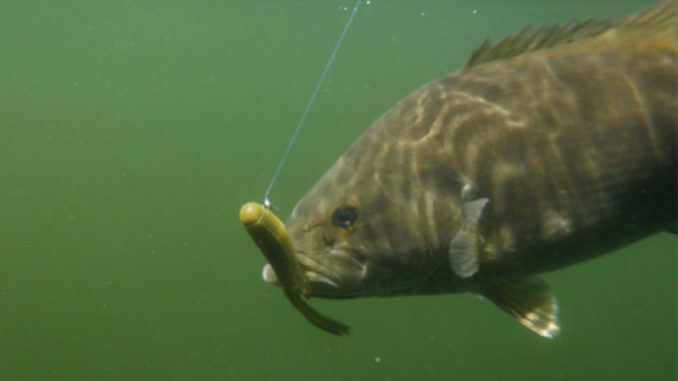
Cooling water, thriving baitfish send Lake James bronzebacks into feeding frenzy
As the easternmost reservoir in North Carolina that holds good numbers of smallmouth bass, Lake James holds a great attraction for many fishermen. And autumn might be the most-productive time to be on the 6,812-acre lake.
You see, it’s topwater time. Nothing like a 2- or 3-pound smallmouth crushing a big topwater bait, then crashing through the surface to a height of several feet, head shaking and gills clattering as it tries to send the plug back in your direction.
“Come October, the topwater bite will be on,” said Mike Goodman, who lives near the lake and fishes it regularly.
Guide Tim Laws of Tarheel Outdoor Adventures said James is full of smallmouth — and lots of good ones.
“You can expect to connect with numbers of fish. And it’s very possible you could find yourself tangling with a true trophy smallmouth,” he said. “Lots of 4-pound-plus fish live here, and they tend to school by size. So find one, and you’re likely to find plenty more. And big largemouth often roam with the smallies, cleaning up the leftovers. And anglers catch plenty of them as well.”
The weather is cooling perfectly for smallmouth
Lake James is the uppermost reservoir on the Catawba River. It impounds both the Catawba and Linville rivers a few miles west of Morganton and east of Marion, straddling the border between Burke and McDowell counties. Much of its 150 miles of shoreline is jam up against the mountains, overlooked by Grandfather Mountain and the Blue Ridge Parkway. Built by Duke Power in 1916, James is impounded by two dams – Linville and Bridgewater — and has two distinct arms.
When the weather begins to cool, that’s when Laws said the fishing begins to take off.
“Usually in October it starts to be really cool, the nights especially,” said Laws. “That triggers them. They start to move shallow and start feeding up for the winter. In September, it can still be kind of warm, but in October, you’ve got highs in the 60s and lows at night might drop into the 30s.”
Laws said being able to put two features together is a key to tangling with Lake James bass in the fall. Look for rocks and deep water.
The rocks hold shad and crayfish — and smallies
“I will spend the majority of my time focusing on main-lake flats in the lower half of both river arms, said Laws, who lives in nearby Old Fort. “Look for areas with rock and access to deeper water should an early cold front move through. Many times, they will school in the deeper, open water near the flats and points, sometimes in water as deep as 80 feet. As the day warms up and the sky gets bright, they move to the points and hold near the rocks on the bottom.
“If you see rocks above the water, they will most likely extend below the water. A quick study of a good topo map and a good color depthfinder/GPS unit is a great asset as well. A quick pass over an area will show you bottom and its composition and where fish are positioned along the structure.”
Goodman said the smallmouth will be around rocks for two reasons.
“That’s where the shad and crayfish are. So the smallmouth will be there, too,” he said.
The size of autumn shad is one reason, Goodman said, that Lake James bass tend to like bigger lures than you’d normally associate with smallmouth bass. The gizzard and threadfin shad have grown throughout the spring and summer and have reached pretty good sizes. So bass are keying on baits in a similar profile.
Don’t be afraid to upsize your lures this time of year
“The smallmouth on this lake like a big bait,” Goodman said. “I like a big bait like a Super Spook.”
Gizzard shad make up the majority of the forage base at James. By the fall, most of those baits are three to four inches long. That’s a perfect match, he said, for a Spook Jr. But he’s caught fish on baits as big as Goodman’s Super Spook.
“I use a Spook Jr. in a sexy shad color for surface smallmouth,” Laws said. “Usually the smallmouth prefer a medium to fast retrieve, pausing every 10 feet or so. Often, they will come back and annihilate it.”
Also, when smallmouth are schooling, feeding at the surface, a big topwater bait trailing a small spoon, often called an ice fly, may be just the ticket. An Alabama rig will also catch lots of schooling smallmouth. The largest smallmouth in such a band may be feeding on shad that smaller bass have injured and are sinking gradually. For those fish, a 3-inch tube grub or swim bait on a jighead will catch bigger fish, Laws said.
Keep numerous rods rigged and ready
Laws said the action can sometimes be fast and furious, but also short-lived. So he keeps several rods rigged with topwater baits on his casting deck. If he hooks a smallmouth, he often tucks that rod under his arm, picks up another rod and casts again, hoping for a doubleheader.
“Sometimes, they come up and stay up. And sometimes, they’ll come up in one spot for 30 seconds, then come up 50 yards away for a minute, then come up somewhere else,” he said. “If you’re within casting range when they come up, you’ll catch ‘em.”
For the long casts sometimes necessary to reach schooling fish, Laws uses a 7-foot, medium-action baitcasting rod paired with a fast-retrieve ratio reel spooled with 17-pound mono.
“I can make super-long casts with this setup to cover lots of water searching to fire up a school or reach a distant school,” he said. “The medium action allows plenty of flex to not pull hooks out or stretch the mono when you’re hooked up to a big smallie. (And) the heavy mono allows me to work the bait with a much more erratic action.”
Subsurface lures are also effective
Lipless crankbaits are productive for schooling smallmouth. Anglers can cast a suspending Sebile Flatt Shad a country mile. These lures can reach distant schooling fish and suspend at the level of fish feeding below the visible surface activity.
When smallmouth aren’t schooling or chasing bait at the surface, Laws goes with a spinnerbait. Goodman prefers a crankbait.
Laws likes to use a 3/8-ounce Bionic Custom Baits spinnerbait with Nos. 4 or 5 willow-leaf blades to match the size of the bait.
“When the schools are active but not feeding directly on the surface, or when they move into brushy cover along the banks on sunny, windy days, this is the bait I’m going to pick up,” he said. “You can’t really fish a blade too fast for a smallmouth. They are designed to be able to chase a bait down. And that extra speed will often trigger an aggressive fish.”
Goodman likes to throw a Fat Free Shad crankbait and prefers the “foxy shad” or crayfish colors.
“The shad in Lake James have a goldish tint. So the Foxy Shad color works. Brown ones suggesting crayfish are also good,” he said.
The bottom also holds smallmouth
Goodman also drags a variety of lures along the bottom.
“In autumn I’m always ready to fish slow across the bottom,” he said. “I use a shakey head jig and a 5- or 6-inch Yum Dinger. Sometimes they really want that. They hit like they are trying to kill it in one blow. The Booyah Pro Boo Bug, a finesse jig, is another lure I fish along the bottom. Just drag it along.”
Goodman prefers green pumpkin or watermelon red for bottom and finesse fishing. “Red is a really good color on this lake,” he said. “And for my soft lures, I always add a spray attractant.”
Chris Wood, a fisheries biologist with the NCWRC, said Lake James has an excellent population of smallmouth bass.
“Our last Lake James report focusing on smallmouth is from 2006. Over 45 percent of smallmouth collected exceeded 12 inches,” he said. “Fish up to age eight are often captured. But the majority of fish collected are four years old or younger. Growth rates are above average, up to age four. Then they slow dramatically in the older age classes.
Smallmouth thrive in Lake James
“Overall, the smallmouth bass population in Lake James is comprised of relatively fast-growing fish in moderate condition, which appears to be exploited at low levels based on the presence of multiple year classes and moderate mortality estimates. The presence of multiple year classes also suggests consistent recruitment.”
The schooling activity at James in the fall is often opposite what most anglers would expect. The best action is often at mid-day, after the sun has warmed the surface water a few degrees.
“A lot of it depends on the water temperature, how cold it gets,” Low said. “The colder it gets, the less active the shad are. So it will be mid-day when the water starts to warm up before the shad actually move up. The smallmouth follow right behind them.
“The smallmouth are really biting best at mid-day between Halloween and Thanksgiving in most years.”
DESTINATION INFORMATION
HOW TO GET THERE — Lake James is the uppermost reservoir on the Catawba River system, a few miles north of I-40 west of Morganton, near Marion. Take exit 100 (Dysartsville) to most of the public boat ramps: Black Bear off Lake James Rd. and, Hidden Cove and Canal Bridge in Lake James State Park.
TACKLE/TECHNIQUES — Medium-action baitcasting tackle with long rods for making long casts to schooling smallmouth bass is the ticket. Big topwater baits such as Zara Spooks, Super Spooks and Spook Jrs. are particularly effective. When fish aren’t schooling, lipless crankbaits, spinnerbaits and deep-diving crankbaits can produce strikes.
FISHING INFO/GUIDES — Tim Laws, Tarheel Outdoor Adventures, 828-803-0463; Foothills Marine, Morganton, 828-439-9022. See also Guides & Charters in Classifieds.
ACCOMMODATIONS — Comfort Inn, 178 US Highway 70 West, Marion, 866-611-6301; Hampton Inn, 3560 US Highway 221 South, Marion, 828-652-5100; Lake James State Park (camping), 828-584-7728
MAPS — Kingfisher Maps, 800-326-0257 or www.kfmaps.com; DeLorme North Carolina Atlas and Gazatteer, 800-5611-5105 or www.delorme.com.
Click here to read about catching smallmouth on Lake Fontana.

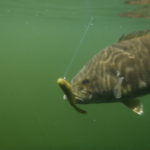
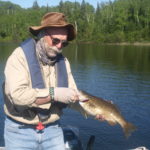
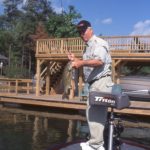

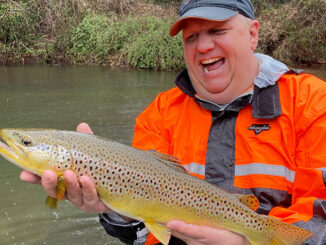

Be the first to comment